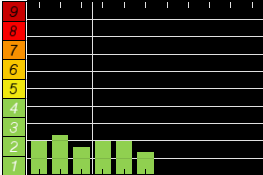By John Berry GM8JBJ
On 12th May I bounced signals off the Moon.
OK, I’d been bouncing signals off the Moon ever since I put up the antenna system a fortnight before. Just that I didn’t know there was anyone on the other end to decode my 13-character message. Until, that is, on the 12th Mr Potts, callsign NC1I, replied from Massachusetts, USA.

Moonbounce (or Earth-Moon-Earth, EME) communication is a very cool thing to do. Just imagine the cred you’d get when next in a bar and you throw that out there when things go quiet.
And importantly, anyone can do it.
Background
The Moon is about 400,000km away (less at perigee, more at apogee). Hence, the flight time for a signal from Earth to Moon and back is about 2.7 seconds. The corresponding round-trip free-space path loss for a signal is a huge 400dBi – no way anyone can bridge that gap. But whilst the Moon is a poor point reflector with a reflection coefficient of 6.5%, it’s also a 3,500km diameter billboard that reflects from all points across its area. The result is a real total path loss of around 250dBi and that’s (just) low enough for radio amateurs to exploit our natural satellite to communicate almost globally.
Basic Kit
Today, almost everyone uses Joe Taylor (K1JT)’s ultra-narrow-band algorithms to code and send a very short message. The message is pared to the bone – it’s even skinnier than FT8. And using his software, WSJT-X, this is sent repeatedly. So, you need a computer, a sound card, and the application. The setup is the same as for FT8, but you’ll configure to use Q65B with a 60-second period.
The transmission modulates the audio of a rig and uses upper sideband (USB). The simplest bands for moonbounce are 144MHz and 432MHz. 1296MHz is another option, but above 432MHz you’ll need a high stability reference to hold the frequency steady and 23cm kit gets expensive. Of course, you could do it at any GHz frequency amateur band, but I’m assuming no-one starts at 10GHz or the like. So, you need a VHF/UHF SSB rig.
And then there’s the antenna.
Antenna
There are three options when it comes to antennas: huge, big, and modest. Huge VHF/UHF antennas are for Americans and others with acres of land. They are typically 48 or more stacked and bayed Yagis. Since you must point at the Moon, you can imagine the mechanics and electronics to automatically rotate and elevate 48 Yagis. Radio amateurs with huge antennas are the heavy lifters of the moonbounce world. Without them, novices wouldn’t get off the ground.

Then there’s big. ‘Big’ describes folk like me who put up four or more Yagis. That’s easily done. It’s all standard kit. My antennas are on a five-metre scaffold pole. Yaesu and others make az/el rotators, and at VHF/UHF the feeder doesn’t cost a mortgage. Automatic Moon tracking can be done on an Arduino or the like. And many folk in this bracket run 500W.

Finally, there’s modest. There’s a whole movement of folk who use single Yagis and a barefoot rig. And many of those use a lightweight long Yagi mounted on a homebrew tripod. The advantage of this is that you can also avoid spending on a rotator, or on a low noise pre-amp (since you’ll be close to the Yagi feed point). These simple systems are often used /P from some piece of open high ground.

Personal Qualities
There are two. Belief (that you can do it). And patience.
It also helps if you do a lot of research to optimise your kit.
Results
The software does everything for you. But you must do the research to know when is best to try.
Conclusion
The truth is that Moonbounce is not that easy. There are several propagation mechanisms that will thwart your attempts.
First, there’s Faraday rotation. The polarisation of the transmitted wave is sometimes distorted along the path. And there’s nothing you can do about it – save use rotatable antennas, and that’s hugely complex.
Then there’s libration fading. The Moon wobbles. And sometimes the reflected waves received back on Earth create an interference pattern in time with deep fades. There’s nothing you can do but wait till the effect stops.
And of course, it’s stupid to try when the Moon and Sun are both within your antenna’s beam. The Sun adds noise to a sensitive system. But you can just wait till the Moon is on its own.
And then there’s the little issue of few folk listening at any point in time. But you can always arrange a sked on a chat room.
None of these issues diminish its street cred. They even enhance it because they make it complicated.
But here’s the secret. Given the simplicity of the kit, anyone can do it.
Links
More detail from John Berry GM8JBJ https://hamradio.engineering/moonbounce-eme/
John Berry QRZ page https://www.qrz.com/db/GM8JBJ
NC1I QRZ page https://www.qrz.com/db/NC1I
HamRadio.me EME on a Budget https://www.hamradio.me/operating-tips/eme-on-a-budget-part-2.html
WSJT-X Digimode Software https://wsjt.sourceforge.io/

0 Comments.